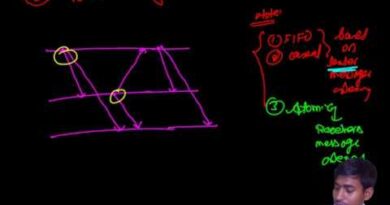MULTICAST COMMUNICATION-HYBRID ORDERING-ATOMIC MULTICAST AND BULLY ALGORITHM
Multicast Communication-Hybrid Ordering-Atomic Multicast And Bully Algorithm Hybrid Ordering Atomic Multicast Bully Algorithm Ordered End-To-End Multicast For Distributed Multimedia Distributed Network Systems. Dynamic Group Communication Multicast Ordering Ordered Multi casting.
Contents
- 0.1 Multicast Communication & Ordering in Distributed Systems
- 0.2 What is Multicast Communication?
- 0.3 Hybrid Ordering in Multicast Communication
- 0.4 Types of Message Ordering:
- 0.5 Atomic Multicast
- 0.6 Bully Algorithm (Leader Election in Distributed Systems)
- 0.7 Steps in the Bully Algorithm:
- 0.8 Conclusion
- 1 📡 MULTICAST COMMUNICATION
- 2 🧩 HYBRID ORDERING
- 3 💣 ATOMIC MULTICAST
- 4 👑 BULLY ALGORITHM (Leader Election)
- 5 🧠 Summary Table
Multicast Communication & Ordering in Distributed Systems
What is Multicast Communication?
Multicast communication is a message transmission method in distributed systems where a sender transmits messages to multiple recipients simultaneously. This improves efficiency & consistency in distributed applications.
Types of Multicast Communication:
Unicast – Message sent to a single receiver.
Multicast – Message sent to multiple specified receivers.
Broadcast – Message sent to all nodes in the network.
Hybrid Ordering in Multicast Communication
Hybrid ordering is a method that combines different message delivery orderings to optimize performance and consistency in distributed systems.
Types of Message Ordering:
- FIFO Ordering (First-In-First-Out): Messages from a sender are received in the same order they were sent.
- Causal Ordering: If message M1 influences M2, all receivers must see M1 before M2.
- Total Ordering: All nodes receive messages in the same global order, ensuring consistency.
- Hybrid Ordering: A combination of FIFO, causal, or total ordering based on the system’s needs.
Example Use Case: In cloud-based applications, hybrid ordering ensures fast processing while maintaining important dependencies.
Atomic Multicast
Definition: An atomic multicast ensures that either all intended recipients receive a message, or none receive it. This maintains system consistency even during failures.
Key Properties:
Reliability: If one recipient gets the message, all must get it.
Consistency: Messages must be delivered in the same order to all processes.
Fault Tolerance: Can recover from failures using rollback techniques.
Example Use Case:
- Bank transactions: Ensures a transfer request reaches both sender and receiver accounts or none at all.
Bully Algorithm (Leader Election in Distributed Systems)
Definition: The Bully Algorithm is used for leader election in distributed systems. When a leader (coordinator) fails, the highest-priority process (highest ID) takes over.
Steps in the Bully Algorithm:
- A process detects leader failure and starts an election.
- It sends election messages to higher-ID processes.
- If a higher-ID process exists, it responds & starts its own election.
- The process with the highest ID wins and becomes the leader.
- The new leader announces itself to all nodes.
Advantages:
Quickly replaces failed leaders.
Ensures a single leader in the system.
Disadvantages:
- High message overhead in large systems.
- Does not handle concurrent failures well.
Example Use Case:
- Distributed databases (e.g., MongoDB) use leader election to maintain a primary node for handling requests.
Conclusion
Multicast communication improves efficiency in distributed systems.
Hybrid ordering balances speed & consistency in message delivery.
Atomic multicast ensures fault-tolerant messaging.
The Bully Algorithm is a leader election method in distributed environments.
Would you like code implementations for these concepts?
Here’s a clear and organized explanation of the key distributed systems concepts: Multicast Communication, Hybrid Ordering, Atomic Multicast, and the Bully Algorithm — useful for exams like GATE, university studies, or technical interviews.
📡 MULTICAST COMMUNICATION
Multicast communication is a method where a message is delivered from one sender to multiple receivers in a group simultaneously.
✅ Key Types:
-
Unicast – One-to-one
-
Broadcast – One-to-all
-
Multicast – One-to-many (targeted group)
🎯 Why Multicast?
-
Efficient bandwidth usage
-
Synchronization of group data
-
Common in group chats, multiplayer games, video conferencing
🔑 Properties:
-
Group management (joining/leaving)
-
Reliability (ensuring delivery)
-
Ordering (messages arrive in correct sequence)
🧩 HYBRID ORDERING
In distributed systems, message ordering is critical. Hybrid Ordering combines multiple ordering guarantees:
🔄 Combination of:
-
Causal Ordering (preserves cause-effect)
-
Total Ordering (same sequence for all nodes)
-
FIFO Ordering (per-sender order)
📘 Example:
In a collaborative document editor:
-
Causal order ensures changes happen based on previous edits
-
Total order ensures consistency across clients
Hybrid ordering balances performance and consistency, applying stricter rules where needed.
💣 ATOMIC MULTICAST
Atomic Multicast ensures that a message is either delivered to all group members or to none — no partial delivery allowed.
🛡️ Properties:
-
Agreement: If one correct process delivers a message, all do.
-
Integrity: Messages are delivered at most once, and only if sent.
-
Validity: If a correct process multicasts a message, it will eventually be delivered.
🔁 Use Cases:
-
Replicated databases
-
Distributed transactions
-
Fault-tolerant systems
💡 Tip:
Atomic multicast is like reliable multicast + all-or-nothing delivery.
👑 BULLY ALGORITHM (Leader Election)
The Bully Algorithm is used to elect a coordinator (leader) in a distributed system.
📜 Steps:
-
A process notices the leader is down.
-
It sends an election message to all processes with higher IDs.
-
If no response, it becomes the leader.
-
If someone replies, it waits for a new leader announcement.
-
The process with the highest ID becomes the leader.
🔄 Example:
If process 3 detects the leader (process 5) failed, it sends election messages to 4 and 5.
-
If 4 responds → 4 will handle election.
-
Eventually, 5 (highest ID) will be leader if alive.
✅ Properties:
-
Guarantees a leader
-
Works even with crash recovery
-
Simple but not very efficient for large networks
🧠 Summary Table
| Concept | Description |
|---|---|
| Multicast | One-to-many communication |
| Hybrid Ordering | Combines causal, total, FIFO ordering |
| Atomic Multicast | Message is either delivered to all or none |
| Bully Algorithm | Elects leader with the highest ID in case of failure |
Would you like:
-
A diagram for each concept?
-
A practice quiz (GATE style)?
-
A short-notes PDF for quick revision?
Let me know!



